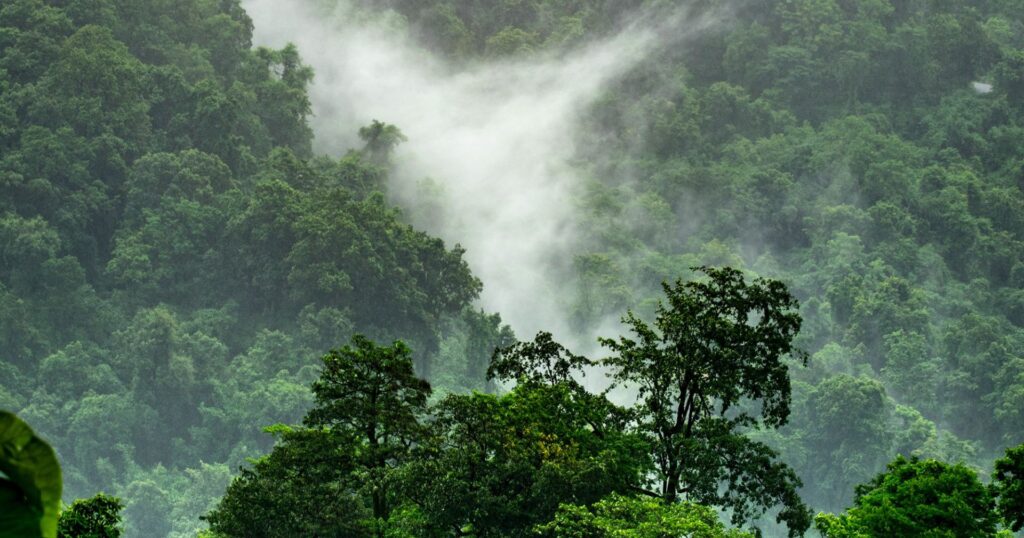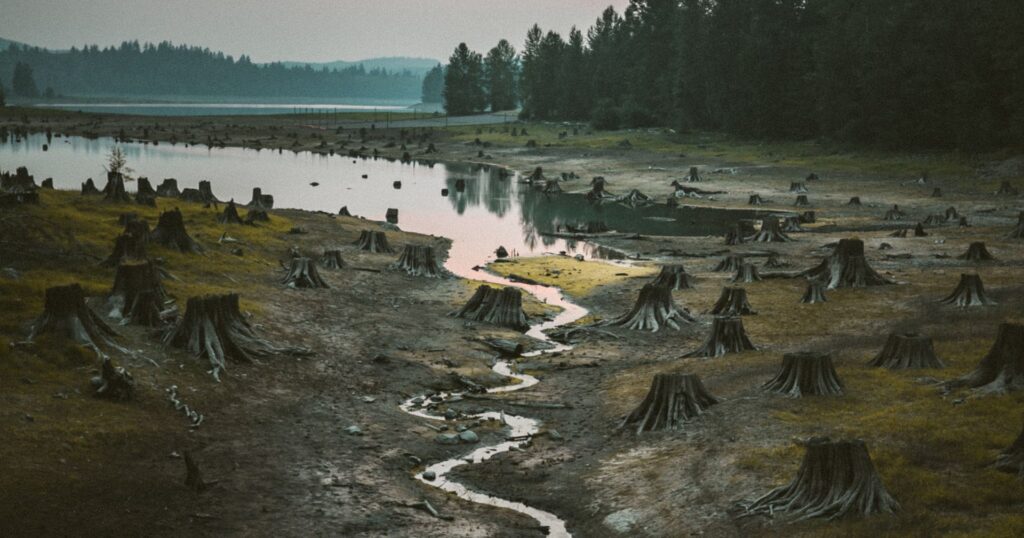Our forests are known as the lungs of the earth, as they produce oxygen while absorbing carbon dioxide. But deforestation has become a significant threat to their health and well being.
With far-reaching consequences, deforestation is a major global issue that impacts humans, wildlife, biodiversity, climate change, and our local economies alike.
In this article, we will discuss:
- The impact of deforestation
- The importance of forests in maintaining ecological balance
- How does deforestation impact our environment?
- How can we stop deforestation?
- How sustainably sourced wood products can help our environment
The Impact of Deforestation
Deforestation is the clearing or thinning of our forests, usually for agricultural, commercial, or residential use. Its impact is far-reaching and has significant consequences.
It’s estimated that roughly 18.3 million acres of forest, equivalent to 27 soccer fields, are lost daily due to deforestation.
It’s time to take action and prioritize sustainable land use practices that allow us to preserve our forests for future generations.
The importance of forests in maintaining ecological balance
While deforestation may seem like a necessary evil to accommodate growing populations and expanding industries, the consequences are severe and far-reaching.
One of the most crucial roles of forests is to maintain ecological balance.
Forests are essential to the health and well-being of our planet. They provide habitat and food for countless animal species, regulate the earth’s climate, and help purify air and water.
They also absorb and store water in the soil. This acts as a natural sponge, preventing floods during heavy rainfall and providing water during dry spells.
The loss of forests disrupts this balance, leading to soil erosion, water pollution, and flooding in previously protected areas.

How does deforestation impact our environment?
1. Deforestation’s effects on biodiversity and wildlife
Deforestation has a significant impact on biodiversity and wildlife.
Forests are home to many plant and animal species, many of which are forest natives that can’t be found anywhere else on the planet.
Deforestation forces wildlife from their homes and destroys their food sources. As a result, many species are pushed to the brink of extinction because they are unable to survive in their new environment.
For example, orangutans, native to the rainforests of Southeast Asia, are considered to be a critically endangered species, as their habitats are destroyed for palm oil plantations.
The loss of biodiversity has a ripple effect on other species and ecosystems. When one species goes extinct, it can have a domino effect on other species that rely on it for food. This can lead to a chain reaction that will ultimately impact our way of life.
Deforestation also affects migratory species that rely on forests for their annual migration.
An example of this is the monarch butterfly, which migrates from Canada to Mexico. They rely on the forests of North America for their habitat.
But due to deforestation in these areas, we are now seeing a decline in the monarch butterfly population, which could have severe consequences for the ecosystems they inhabit.
What animals are most impacted by deforestation?
When unconventional production practices take down trees and use dangerous chemicals that destroy our forests, it threatens our wildlife.
There are two estimates in regard to how many species inhabit our earth. On the low end, it’s estimated that there are around 2 million different species on our planet. On the high end, the number is closer to 100 million.
Whether we look at the high or low end estimate, we know that somewhere between 0.01% and 0.1% of species go extinct yearly.
The animals under the greatest threat from deforestation are:
- Orangutans (especially in Indonesia, Malaysia, and Borneo)
- Elephants (especially in Sumatra and Borneo)
- Indonesian Tigers
- Reptiles, amphibians, and other vertebrates (mainly in Haiti)

2. Deforestation’s contribution to climate change
Deforestation accounts for roughly 20% of global greenhouse gas emissions.
Trees absorb carbon dioxide from the atmosphere through the process of photosynthesis. And when forests are cleared, this carbon is released into the atmosphere, contributing to the increase in greenhouse gases causing global warming.
Not to mention that the destruction of forests in tropical regions, such as the Amazon rainforest, has a particularly large impact on climate change.
These forests are often called the “lungs of the earth” because they absorb vast amounts of carbon dioxide.
The impact of deforestation on climate change isn’t only due to the release of carbon dioxide but also the loss of the cooling effect that forests have on our planet.
Trees absorb heat and moisture from the atmosphere, which helps to regulate the Earth’s temperature. When forests are cleared, this cooling effect is lost, leading to increased temperatures and changes in weather patterns.
Deforestation also contributes to soil erosion, decreased water quality, and changes in the hydrological cycle.
These problems can have a range of impacts, from reduced agricultural productivity to increased frequency and severity of natural disasters, such as floods and droughts.
And deforestation isn’t solely a problem that tropical regions face. Deforestation in Canada has become a serious environmental issue.
The thinning of forests in the snowy regions of Canada can double, or even quadruple, the number of large floods around the streams and rivers that pass through those forests.
This is because the snow on the forest floor is subjected to sunlight, causing it to melt faster.

3. Deforestation’s negative impact on local economies
Deforestation can have a significant impact on local economies, both in the short and long term.
Some industries benefit from deforestation, such as mining and logging.
While these activities may provide short-term economic benefits, the long-term consequences are severe.
Deforestation can lead to soil erosion, decreased water quality, and a loss of biodiversity, all of which can harm local economies.
But one major impact of deforestation is a decrease in ecotourism.
Forests are often popular tourist destinations, attracting visitors worldwide who want to see rare wildlife and unique landscapes.
However, when forests are destroyed, the wildlife and unique landscapes disappear. Tourists then lose interest, and local communities lose out on valuable income from tourism.
As well, deforestation impacts agriculture.
Many farmers rely on forests for their livelihoods, and it’s harder for them to make a living when they’re destroyed. Some may farm in the forests while others use its resources for fuelwood and medicinal plants.
Additionally, deforestation can lead to flooding and other natural disasters, which can destroy homes, crops, and infrastructure.
This can devastate local economies, as people lose their homes, businesses, and sources of income.
How can we stop deforestation?
With the current birth rate and rate of consumption, we’ll need more space to grow food and extract natural resources. The need to turn forests into farmland or mining spots is likely to increase.
So, under these circumstances, how can we stop deforestation?

1. Consume less, use what you have, and shop consciously
When anything we could ever want is just one click away, the consumer in us will continue to make unnecessary purchases.
As consumers, we can choose to buy less, use up what we already have, and shop consciously.
We can opt to purchase products that don’t use palm oil, instead opting for home-made options (that have fewer chemicals and food preservatives).
Shopping eco-friendly or certified brands is also a great way to help combat deforestation.
And when it comes to products you already own: use them.
Electronics are all made with precious materials, and to get these materials, forests need to be cleared to build mining sites. Instead of buying the latest smartphone each year, consider using your current phone until it truly needs replacing.
The need to purchase the latest tech or newest product update creates demand. And that demand means more production and thinner forests.
But without that demand, production will ease, making it unnecessary to clear more space to extract natural resources.
2. Eat less meat
According to the World Wildlife Foundation, livestock is a major contributor to deforestation. And livestock deforestation is responsible for 3.4% of current global carbon emissions every year.
But the most impressive statistic of all? In western countries, reducing our meat consumption by 90% is necessary to curb global warming.
Without dairy and meat consumption, farmland could be reduced by over 75% globally.
Ultimately, eating less meat is a major step toward stopping deforestation and global warming.

3. Sourcing wood sustainably
Wood is a versatile and essential resource. From construction to compostable single-use cutlery, the demand is only increasing.
Wood is a natural material that can break down in natural environments. It won’t leave a trace after it degrades, making it an important material in our fight against waste pollution.
But the need for wood and wood products is one of the primary drivers of deforestation.
Responsible wood-sourcing practices are crucial in ensuring our forests’ long-term health and viability. So, is there a way to responsibly and sustainably source wood to help mitigate deforestation?
One way to sustainably source wood is through responsible forest management. This involves managing forests to maintain their ecological, social, and economic value.
Responsible forest management includes selective logging, reforestation, and protecting endangered species and habitats.
Selective logging involves harvesting only the mature trees in a forest, leaving the younger ones to continue growing and providing a habitat for wildlife.
The next step is reforestation, the planting of new trees to replace those that were harvested, ensuring that the forest remains healthy for years to come.
And lastly, protecting endangered species and habitats ensures that the forest ecosystem remains intact and supports biodiversity by being selective of the areas we’re sourcing from.
Learn More: Single-Use Wood Cutlery: Myths Debunked
Forest Stewardship Council Certification
The Forest Stewardship Council (FSC) assures consumers that the wood products they purchase come from responsibly managed forests.
The FSC certification requires that forest management practices protect biodiversity, uphold workers’ rights, and respect the rights of indigenous peoples and local communities.
If a wood product or service has the FSC logo, buyers can rest assured that their product uses sustainably sourced wood.
However, it’s important to note that certification programs are not a silver bullet solution to deforestation.
There are still significant challenges in ensuring that wood products are sourced responsibly and sustainably.
For example, illegal logging and trade in wood products remain a significant problem, particularly in areas with weak enforcement mechanisms.

How sustainably sourced wood products can help our environment
Wood products can have a positive impact on the environment.
By choosing sustainably sourced wood products, we can help mitigate deforestation and reduce plastic pollution.
Wood products can be recycled and repurposed, reducing the demand for new wood, which in turn reduces deforestation.
Additionally, recycling wood products requires less energy than producing new wood products, minimizing greenhouse gas emissions.
And when we replace single-use plastic with single-use wood products, we can help reduce our pollution problem.
Wood can replace single-use products like cutlery and stir sticks. When consumers finish with these single-use products, they can toss them into a compost bin, where they’ll quickly degrade.
When wood composts, it becomes nutrient-rich soil. Unlike plastic, which breaks down into toxic elements like microplastics, wood won’t leave a trace behind.
From cleaning our air to providing a natural material that can completely biodegrade, our forests greatly help protect our planet.
Wood is a renewable resource, but the severity of deforestation shows us that we don’t treat it as such.
But with responsible sourcing and proper care, our forests can continue to help us fight climate change.
Learn More: 4 Reasons Why Bioplastics Won’t Solve Our Plastic Problem



